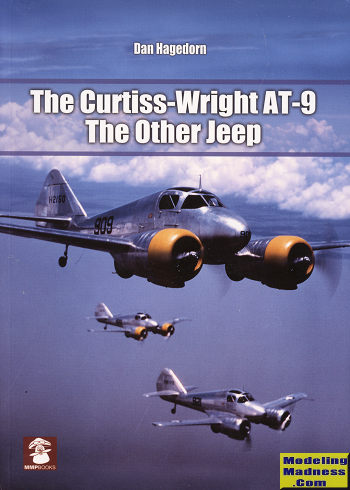Mushroom Model Publications' The Curtiss-Wright
AT-9 - The other Jeep
 One of the main
reasons that the United States was able to provide the required, quality air
crew for its tens of thousands of aircraft during WWII is that robust training
regimen was in place. This require some foresight (rare in military history),
and a lot of training planes. Few realize that the USAAF inventory of 1942 and
into late 1943 was mostly trainers of some sort.
One of the main
reasons that the United States was able to provide the required, quality air
crew for its tens of thousands of aircraft during WWII is that robust training
regimen was in place. This require some foresight (rare in military history),
and a lot of training planes. Few realize that the USAAF inventory of 1942 and
into late 1943 was mostly trainers of some sort.
Most of us think of the T-6 or the
Stearman biplane when we think of WWII trainers, but these planes don't teach
those who are going to pilot fast twin engine or multi-engine bombers. Nor do
they train gunners, navigators or bombardiers. For those roles you have two
choices. One is obsolete front line aircraft. Well in 1941/42, there simply were
not very many of those thanks to the austerity of the 20s and 30s. The other was
either new build planes or adaptations of those already being produced for
civilian use.
Sticking with just pilot trainer twins,
the huge majority of planes that were built for this task were adaptations of
civil types from Cessna or Beech. Neither one of those were as rugged as hoped
and neither were able to properly duplicate the sort of handling and performance
that was needed for a pilot to step into a B-25 or B-26.
This is where the book's subject comes
into play. It was the only specially designed twin engine trainer used during
the war. Unlike its compatriots, it was of all metal construction and was pretty
speedy. It was also designed to be difficult to fly (so was the T-6). It was
Curtiss-Wright, the semi-autonomous division of Curtiss that designed the plane.
These were built in their St. Louis factory, and were pretty much what the AAF
was looking for. Naturally, they were not perfect and some work was needed to
correct a few glitches that always show up in new designs.
The planes served their purpose but after
2-3 years of operation by trainee pilots, they were worn out. Offered post war
for a pittance, none actually entered the civil register and were soon long
forgotten. There is one aircraft at the USAF Musum that is a compilation of many
airframes and the hulk of one at Pima. That's it.
The author of this book, Dan Hagedorn,
requires no introduction to aircraft enthusiasts. His research on this plane has
been second to none and his work shows in how comprehensive this volume actually
is. In addition to the development of the aircraft, we are provided a look at
the airframe itself and notes on what it was like to fly it. Then there is a
section on the Army training scheme and then a look at all the various stations
where the AT-9 was used. Those units that flew the plane are next as well as all
the air bases where training took place. Typical of the time, there would be a
central training station and each station would have a number of outlying
fields. Finally, there is a short blurb on survivors and then a look at the
various camo and markings schemes worn by these planes. This includes
deciphering the code letter/numbers on the fuselage of these aircraft.
Included are a lot of superb photos of
the aircraft including a number of large period photographs. This additional eye
candy is real treat for the enthusiast.
Bottom line is that this is the best book
on the subject every done and I doubt it will ever be eclipsed. It is one I
thoroughly enjoyed reading and one that I can guarantee you will enjoy as well.
July 2019
Copyright
ModelingMadness.com. All rights reserved.
Review book courtesy of
www.casematepublishing.com. Get
yours today
at this link.
If you would like your product reviewed fairly and quickly, please
contact
me or see other details in the Note to
Contributors.
 One of the main
reasons that the United States was able to provide the required, quality air
crew for its tens of thousands of aircraft during WWII is that robust training
regimen was in place. This require some foresight (rare in military history),
and a lot of training planes. Few realize that the USAAF inventory of 1942 and
into late 1943 was mostly trainers of some sort.
One of the main
reasons that the United States was able to provide the required, quality air
crew for its tens of thousands of aircraft during WWII is that robust training
regimen was in place. This require some foresight (rare in military history),
and a lot of training planes. Few realize that the USAAF inventory of 1942 and
into late 1943 was mostly trainers of some sort.